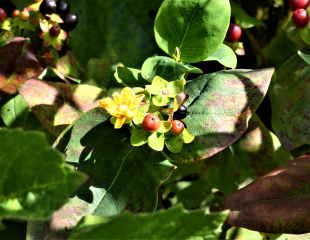


How to grow Hypericum St Johns Wort
Hypericum is commonly known as St John's wort and also Rose of Sharon. Most varieties are deciduous or semi-evergreen and summer flowering with lovely bright yellow flowers and followed, in autumn, by attractive berries. There are many varieties but those commonly sold and grown in gardens are H.x hidcoteense 'Hidcote' and H. calycinum 'Brigadoon'.
Before planting Hypericum, be aware that all parts are toxic to animals and should be handled carefully as contact with the leaves can cause skin irritation. That said, Hypericum is easy to grow and is tolerant of most growing conditions. Hypericum will put up with drought and shade, (although flowers best in sun) but dislikes waterlogged soils. Hypericum has a long flowering season and carries a profusion of blooms as the image top right illustrates.
It is vigorous with a tendency to self seed, and is considered by some to be invasive because of its self seeding.
There is no requirement to prune other than to remove any dead wood in the spring.
There are also dwarf varieties suitable for front of the border or rock gardens such as Pallens.
A plus point of Hypericum is that it is ideal to have as a cut flower both the blooms and later the berries are attractive and frequently used in flower arrangements.
The downside is that St Johns Wort is prone, perhaps we could say, very prone to rust.

Hypericum has a tendency to develop rust, illustrated left. It is not fatal to the shrub, but makes it very unsightly. It will not spread to other neighbouring plants, but it spoils the look of the shrub. If you see a sickly looking Hypericum chances are it has rust.
Personally, if I was planting a Hypericum, rather than go for one of the traditional varieties such as H. hidcote, I would take a punt at the more , developed varieties labelled as "rust resistant." There is no real treatment for it save pruning off the infected leaves and branches. (see below.)
Recommended varieties of Hypericum
Some rust resistant varieties worth checking out are:
Kolster nursery developed the Magical strain in the Netherlands, focusing on strong plant vigor, lovely berries, and rust resistance. An improved generation of Hypericums.
Two of the Magical varieties are available on the Crocus Website (affiliate link) H. 'Magical White', H x inodorum 'Magical Universe' H. Magical Midnight Glow.
How to prune Hypericum
It is not essential to prune Hypericum, but if needed, spring is the time to take the shears to it.
A light prune in early spring if you want to restrict size or tidy up. Some Hypericum are prone to rust and pruning in the spring is one way to remove rust tainted branches. Hypericum also self seed, which is a plus or minus depending on what you want in your garden.
To reduce the problems with rust, the shrub can be cut down at the end of summer and all the rusty leaves removed for a fresh start in the spring. It will still flower and produce berries as Hypericum flower on the current year's wood. In particular, H. calycinum which is vigorous and can be prone to rust so will enjoy being cut back annually to the ground in around February /March time. Hypericum flowers from July to October.

Fully hardy and easy to grow. Most Hypericum need little or no attention and grow in almost any conditions.
